- Back to Home »
- Voyager 1 leaves the solar system
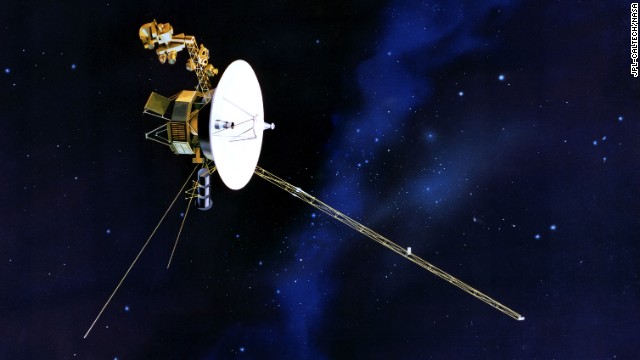 As NASA scientists report that Voyager 1 has left the solar system, take a look at some of the amazing images the probe has provided its earthbound audience.
As NASA scientists report that Voyager 1 has left the solar system, take a look at some of the amazing images the probe has provided its earthbound audience. 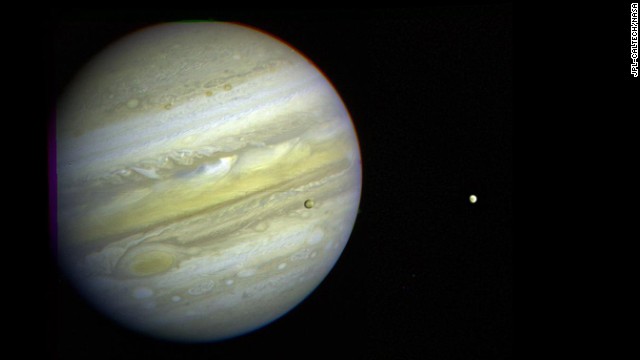 Jupiter, its Great Red Spot and three of its four largest satellites are visible in this photo taken February 5, 1979, by Voyager 1.
Jupiter, its Great Red Spot and three of its four largest satellites are visible in this photo taken February 5, 1979, by Voyager 1. 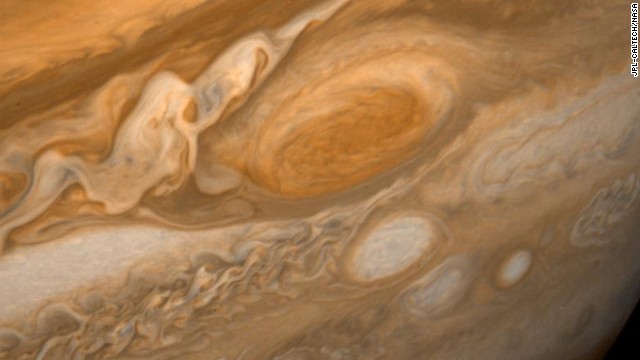 A dramatic view of Jupiter's Great Red Spot and its surroundings was obtained by Voyager 1 on February 25, 1979
A dramatic view of Jupiter's Great Red Spot and its surroundings was obtained by Voyager 1 on February 25, 1979 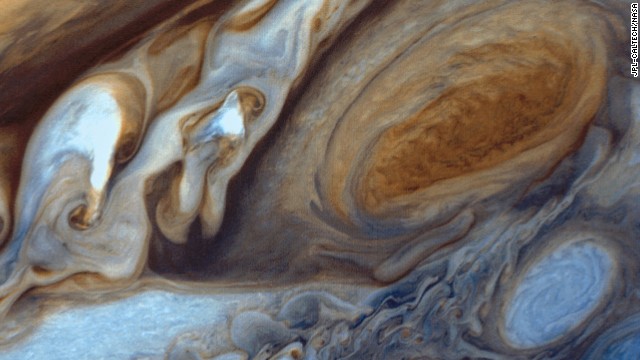 This image of Jupiter was assembled from three black and white negatives from different color filters and recombined to produce the color image.
This image of Jupiter was assembled from three black and white negatives from different color filters and recombined to produce the color image. 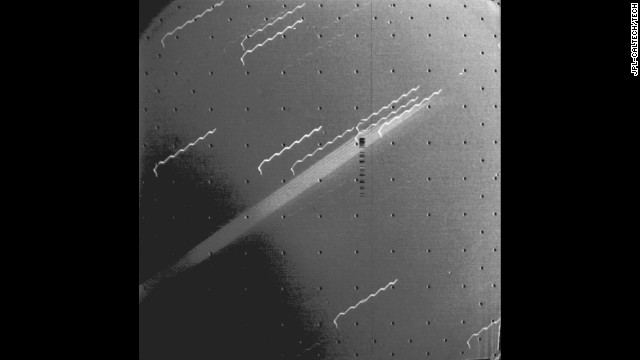 Voyager 1 captured the first evidence of a ring around the planet Jupiter. The multiple exposure of the extremely thin faint ring appears as a broad light band crossing the center of the picture. The background stars look like broken hairpins because of spacecraft motion during the 11-minute exposure. The black dots are geometric calibration points in the camera.
Voyager 1 captured the first evidence of a ring around the planet Jupiter. The multiple exposure of the extremely thin faint ring appears as a broad light band crossing the center of the picture. The background stars look like broken hairpins because of spacecraft motion during the 11-minute exposure. The black dots are geometric calibration points in the camera. 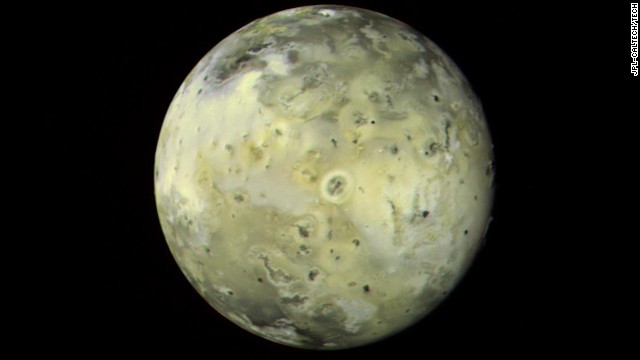 This mosaic image of Jupiter's moon Io shows a variety of features that appear linked to the intense volcanic activity. The circular, doughnut-shaped feature in the center has been identified as a known erupting volcano
This mosaic image of Jupiter's moon Io shows a variety of features that appear linked to the intense volcanic activity. The circular, doughnut-shaped feature in the center has been identified as a known erupting volcano 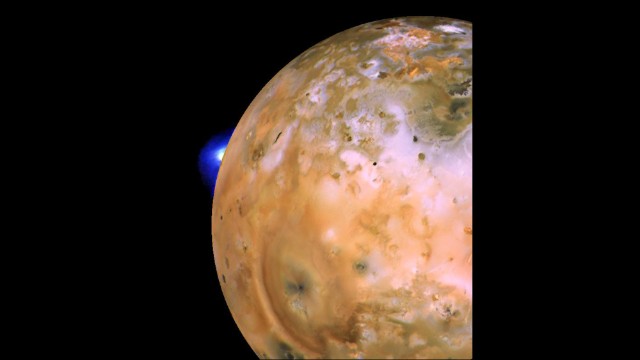 Another image of Io shows an active plume of a volcano dubbed Loki.
Another image of Io shows an active plume of a volcano dubbed Loki. 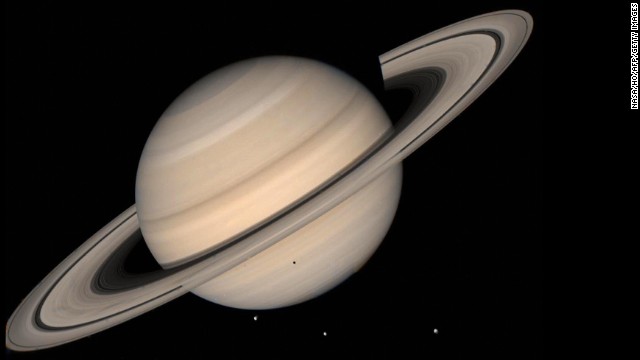 This August 1998 NASA file image shows a true color photo of Saturn assembled from the Voyager 2 spacecraft.
This August 1998 NASA file image shows a true color photo of Saturn assembled from the Voyager 2 spacecraft. 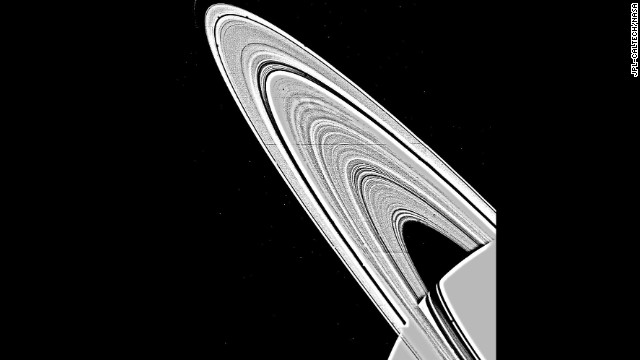 A mosaic image of Saturn's rings, taken by NASA's Voyager 1 on November 6, 1980, shows approximately 95 individual concentric features in the rings. The ring structure was once thought to be produced by the gravitational interaction between Saturn's satellites and the orbit of ring particles, but has now been found to be too complex for this explanation alone.
A mosaic image of Saturn's rings, taken by NASA's Voyager 1 on November 6, 1980, shows approximately 95 individual concentric features in the rings. The ring structure was once thought to be produced by the gravitational interaction between Saturn's satellites and the orbit of ring particles, but has now been found to be too complex for this explanation alone. 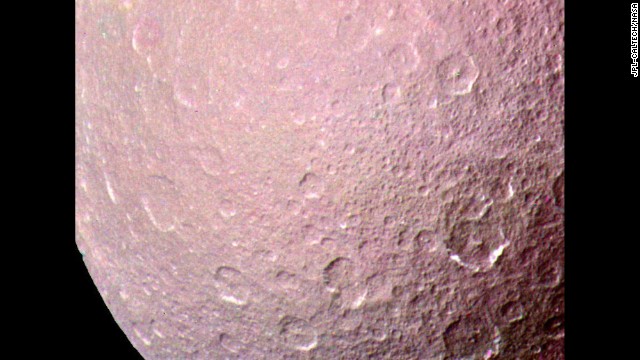 This image of Rhea, the largest airless satellite of Saturn, was acquired by the Voyager 1 spacecraft on November 11, 1980.
This image of Rhea, the largest airless satellite of Saturn, was acquired by the Voyager 1 spacecraft on November 11, 1980.  The cratered surface of Saturn's moon Mimas is seen in this image taken by Voyager 1 on November 12, 1980. Impact craters made by the infall of cosmic debris are shown; the largest is more than 100 kilometers (62 miles) in diameter and displays a prominent central peak.
The cratered surface of Saturn's moon Mimas is seen in this image taken by Voyager 1 on November 12, 1980. Impact craters made by the infall of cosmic debris are shown; the largest is more than 100 kilometers (62 miles) in diameter and displays a prominent central peak. 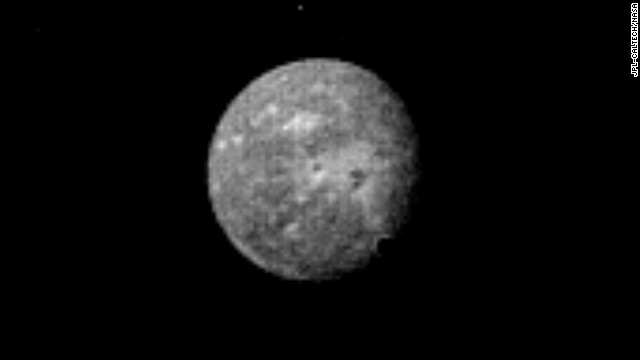 Uranus' outermost and largest moon, Oberon, is seen in this Voyager 2 image, obtained January 22, 1986,
Uranus' outermost and largest moon, Oberon, is seen in this Voyager 2 image, obtained January 22, 1986, 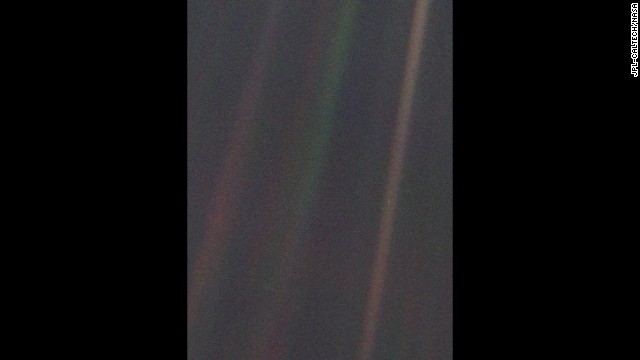 This image of Earth, dubbed "Pale Blue Dot," is a part of the first "portrait" of the solar system taken by Voyager 1. The spacecraft acquired a total of 60 frames for a mosaic of the solar system from a distance of more than 4 billion miles from Earth. Earth lies right in the center of one of the scattered light rays, which are the result of taking the image so close to the sun.
This image of Earth, dubbed "Pale Blue Dot," is a part of the first "portrait" of the solar system taken by Voyager 1. The spacecraft acquired a total of 60 frames for a mosaic of the solar system from a distance of more than 4 billion miles from Earth. Earth lies right in the center of one of the scattered light rays, which are the result of taking the image so close to the sun. 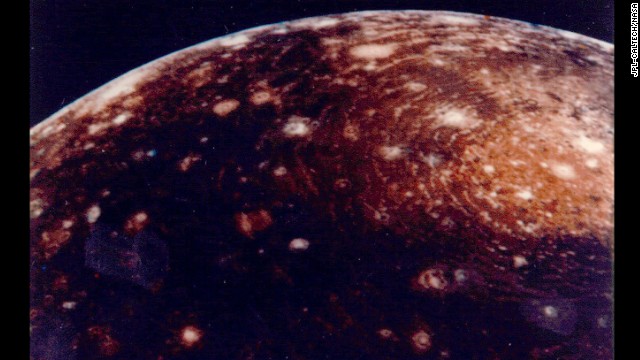 This image of Jupiter's moon Callisto was captured from a distance of 350,000 kilometers. The large "bull's-eye" at the top of the image is believed to be an impact basin formed early in Callisto's history. The bright center of the basin is about 600 kilometers across and the outer ring is about 2,600 kilometers across.
This image of Jupiter's moon Callisto was captured from a distance of 350,000 kilometers. The large "bull's-eye" at the top of the image is believed to be an impact basin formed early in Callisto's history. The bright center of the basin is about 600 kilometers across and the outer ring is about 2,600 kilometers across. 
1

2

3

4

5

6

7

8

9

10

11

12

13

14
- Study: Voyager 1 left heliosphere around August 25, 2012
- Voyager 1 and 2 were launched in 1977, 16 days apart
- Voyager 1 is now the first mission to explore interstellar space
(CNN) -- At the edge of the heliosphere, you wouldn't know by looking whether you left the cradle of humanity behind and floated out into interstellar space. You would just see unfathomably empty space, no matter which side of the invisible line you were on.
But scientists now have strong evidence that NASA's Voyager 1 probe has crossed this important border, making history as the first human-made object to leave the heliosphere, the magnetic boundary separating the solar system's sun, planets and solar wind from the rest of the galaxy.
"In leaving the heliosphere and setting sail on the cosmic seas between the stars, Voyager has joined other historic journeys of exploration: The first circumnavigation of the Earth, the first steps on the Moon," said Ed Stone, chief scientist on the Voyager mission. "That's the kind of event this is, as we leave behind our solar bubble."
A new study in the journal Science suggests that the probe entered the interstellar medium around August 25, 2012. You may have heard other reports that Voyager 1 has made the historic crossing before, but Thursday was the first time NASA announced it.
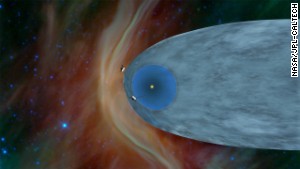 NASA: Voyager 1 has left solar system
NASA: Voyager 1 has left solar system 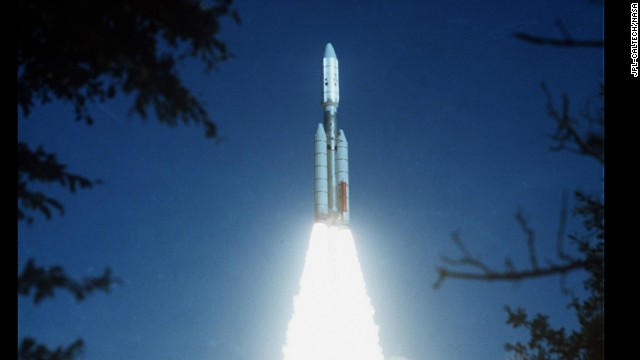 As it's sister probe Voyager 1 leaves our solar system, take a look at some of the images provided by Voyager 2. Here, Voyager 2 launches on August 20, 1977.
As it's sister probe Voyager 1 leaves our solar system, take a look at some of the images provided by Voyager 2. Here, Voyager 2 launches on August 20, 1977. 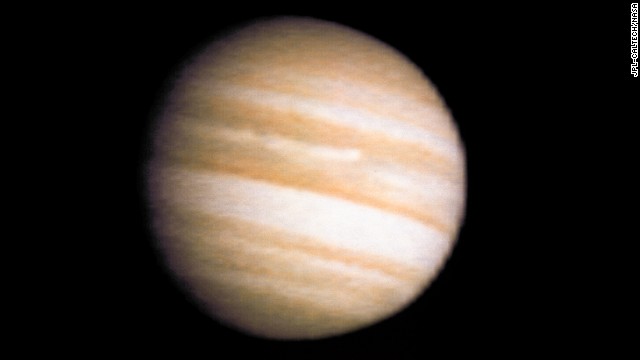 Voyager 2's view of Jupiter during the spacecraft's approach.
Voyager 2's view of Jupiter during the spacecraft's approach. 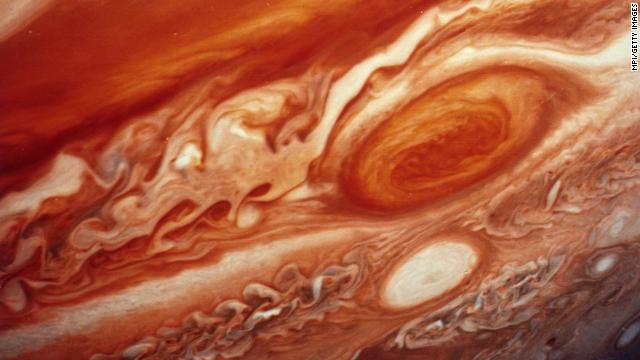 Voyager 2 provided this image of Jupiter's red spot.
Voyager 2 provided this image of Jupiter's red spot. 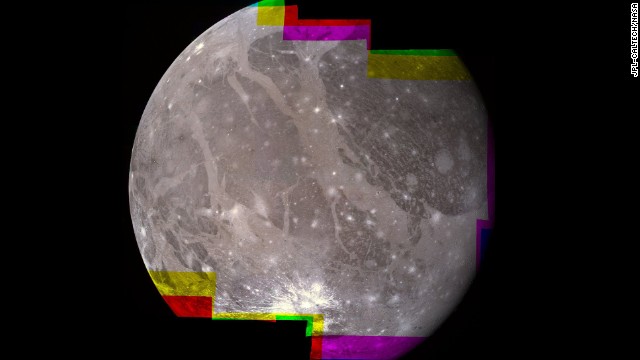 Ganymede, the largest of Jupiter's moons, is the largest moon in our solar system.
Ganymede, the largest of Jupiter's moons, is the largest moon in our solar system. 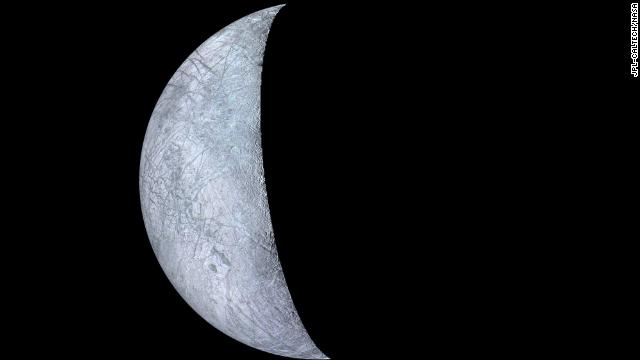 A mosaic of Europa, Jupiter's smallest moon, shows bright areas, likely ice deposits, and darker areas that may be the rocky surface or areas with a more patchy distribution of ice. The most unusual features are systems of long linear structures that cross the surface in various directions, some of which are more than 1,000 kilometers long and about 2 or 3 kilometers wide.
A mosaic of Europa, Jupiter's smallest moon, shows bright areas, likely ice deposits, and darker areas that may be the rocky surface or areas with a more patchy distribution of ice. The most unusual features are systems of long linear structures that cross the surface in various directions, some of which are more than 1,000 kilometers long and about 2 or 3 kilometers wide.  This August 1998 NASA file image shows a true color photo of Saturn assembled from Voyager 2 photos.
This August 1998 NASA file image shows a true color photo of Saturn assembled from Voyager 2 photos. 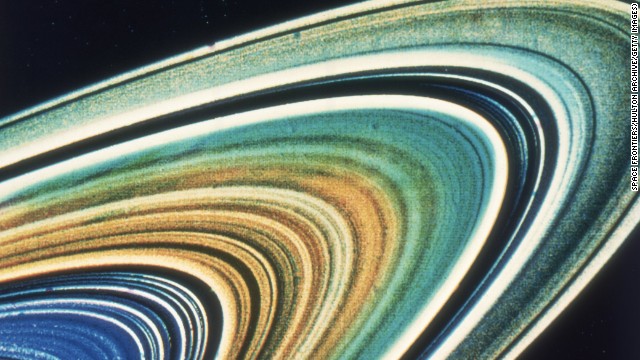 An enhanced color image of Saturn's rings, as seen by Voyager 2.
An enhanced color image of Saturn's rings, as seen by Voyager 2. 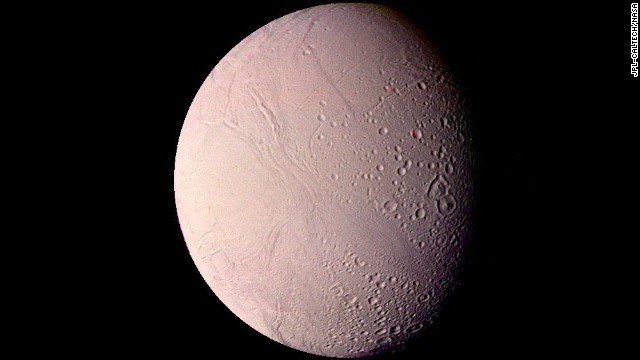 This image of Saturn's moon Enceladus shows impact craters up to 22 miles in diameter, as well as smooth uncratered areas.
This image of Saturn's moon Enceladus shows impact craters up to 22 miles in diameter, as well as smooth uncratered areas. 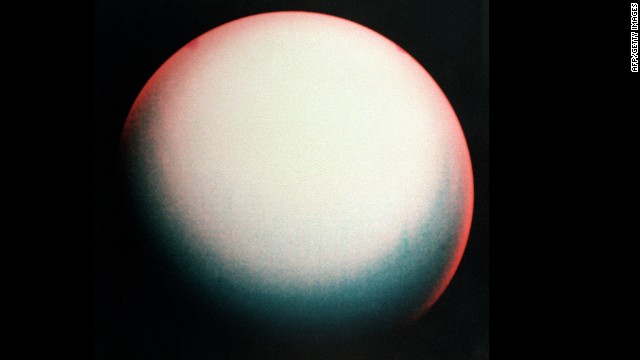 A false color view of Uranus made from images taken by Voyager 2.
A false color view of Uranus made from images taken by Voyager 2. 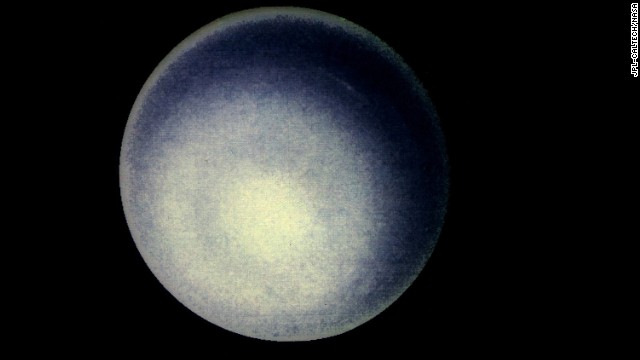 A computer enhancement of a Voyager 2 image emphasizes the high-level haze in Uranus' upper atmosphere. Clouds are obscured by the overlying atmosphere.
A computer enhancement of a Voyager 2 image emphasizes the high-level haze in Uranus' upper atmosphere. Clouds are obscured by the overlying atmosphere. 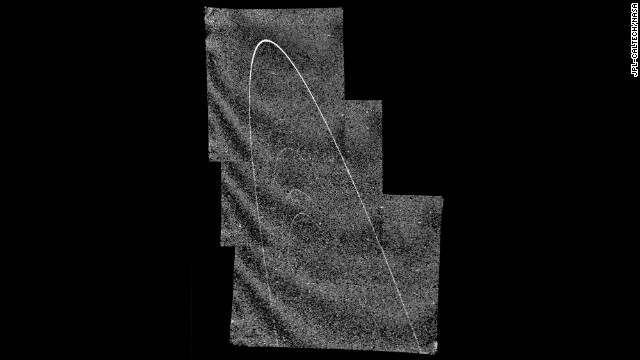 Uranus' rings, photographed by Voyager 2 as it approached the plane of the Uranian ring system.
Uranus' rings, photographed by Voyager 2 as it approached the plane of the Uranian ring system.  Oberon, Uranus' outermost moon, shows several impact craters on the moon's icy surface.
Oberon, Uranus' outermost moon, shows several impact craters on the moon's icy surface. 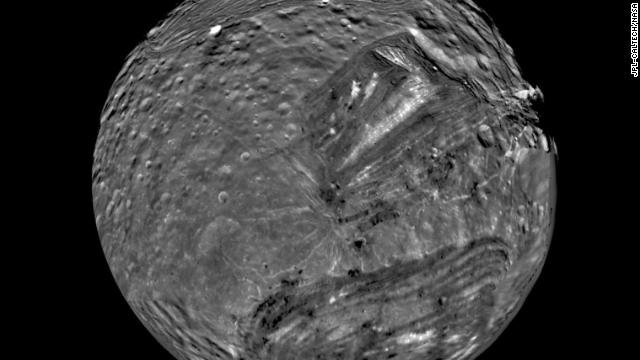 Miranda is the the 11th known satellite of Uranus. The moon was essential in the Voyager 2 mission in that it provided a gravity assist to propel the craft on toward Neptune.
Miranda is the the 11th known satellite of Uranus. The moon was essential in the Voyager 2 mission in that it provided a gravity assist to propel the craft on toward Neptune. 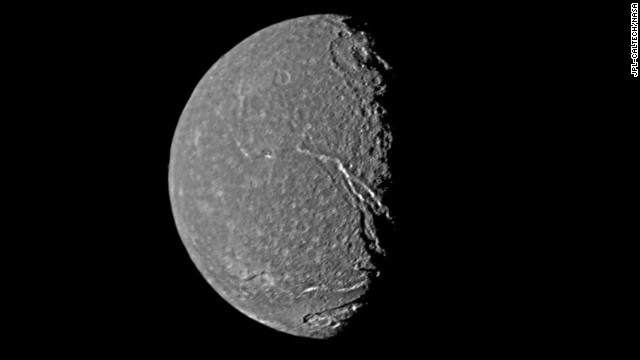 Uranus' moon Titania shows a crater-pocked surface as well as prominent fault valleys that stretch across the moon.
Uranus' moon Titania shows a crater-pocked surface as well as prominent fault valleys that stretch across the moon. 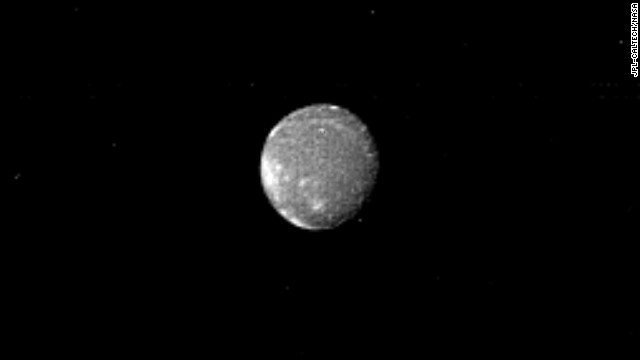 Distinct bright patches are visible on Ariel, the brightest of Uranus' five largest satellites.
Distinct bright patches are visible on Ariel, the brightest of Uranus' five largest satellites. 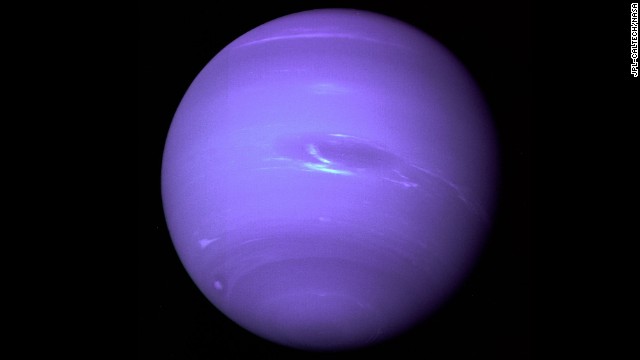 This picture of Neptune shows the Great Dark Spot and its companion bright smudge.
This picture of Neptune shows the Great Dark Spot and its companion bright smudge. 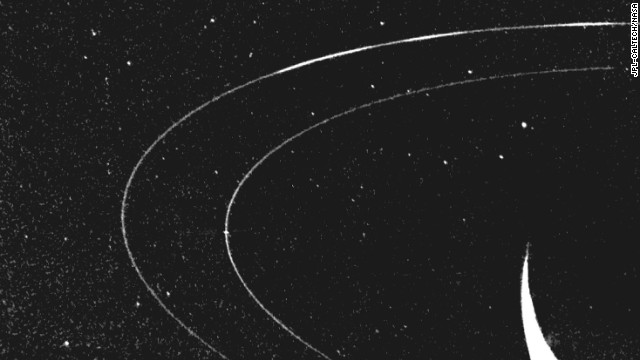 This image of Neptune's outermost ring shows how material clumps into three arcs.
This image of Neptune's outermost ring shows how material clumps into three arcs. 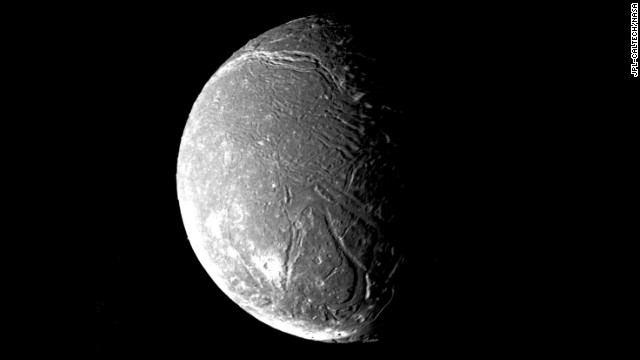 Ariel, another of Uranus' satellite's, shows a densely pitted surface that is also crisscrossed with numerous valleys and fault scarps.
Ariel, another of Uranus' satellite's, shows a densely pitted surface that is also crisscrossed with numerous valleys and fault scarps. 
1

2

3

4

5

6

7

8

9

10

11

12

13

14

15

16

17

18
 Images from Voyager 2
Images from Voyager 2 The twin spacecraft Voyager 1 and 2 were launched in 1977, 16 days apart. As of Thursday, according to NASA's real-time odometer, Voyager 1 is 18.8 billion kilometers (11.7 billion miles) from Earth. Its sibling, Voyager 2, is 15.3 billion (9.5 billion) kilometers from our planet.
Voyager 1 is being hailed as the first probe to leave the solar system. But under a stricter definition of "solar system," which includes the distant comets that orbit the sun, we'd have to wait another 30,000 years for it to get that far, Stone said.
Another milestone for long after we're gone: The probe will fly near a star in about 40,000 years, Stone said.
How do we know?
Voyager, currently traveling at more than 38,000 miles per hour, never sent a postcard saying "Greetings from interstellar space!" So whether it has made the historic crossing or not is a matter of controversy.
"The spacecraft itself really doesn't know," Stone said. "It's only instruments that can tell us whether we're inside or outside."
Further complicating matters, the device aboard Voyager 1 that measures plasma -- a state of matter with charged particles -- broke in 1980.
To get around that, scientists detected waves in the plasma around the spacecraft and used that information to calculate density. Vibrations in the plasma came from a large coronal mass ejection from the sun in 2012, resulting in what Stone called a "solar wind tsunami." These vibrations reached the area around Voyager this spring.
Measurements taken between April 9 and May 22 of this year show that Voyager 1 was, at that time, located in an area with an electron density of about 0.08 per cubic centimeter.
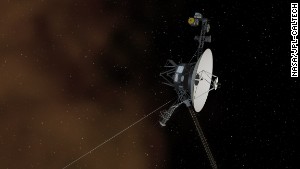
In the interstellar medium, the density of electrons is thought to be between 0.05 and 0.22 per cubic centimeter. The particles of interstellar plasma were created by the explosions of giant stars, and carry the magnetic field of the galaxy, scientists said.
Last year, between October 23 and November 27, researchers calculate that Voyager 1 was in an area with an electron density of 0.06 per cubic centimeter. That's still within the interstellar space range, and it means that over time the spacecraft passed through plasma with increasing electron density.
The study, led by University of Iowa physicist Donald Gurnett, suggests that the plasma density is about 30 times higher in the interstellar medium than in the heliosphere, which is close to what scientists thought based on other kinds of measurements. The boundary is called the heliopause.
When did it happen?
Scientists have been using several kinds of measurements to figure out if and when Voyager 1 had reached the interstellar medium.
Evidence from particle data had already pointed toward the conclusion that the probe succeeded. In late July and early August of 2012, scientists saw dips in the concentration of particles made in the solar system, and peaks in particles made outside.
"If you just looked at that data, you'd think it's pretty clear that we've actually crossed a boundary. We're no longer in the place where the solar system particles are being made, and we're actually out in the interstellar medium," said Marc Swisdak, associate research scientist in the Institute for Research in Electronics and Applied Physics at the University of Maryland. Swisdak was not involved in the new study, but has worked with Voyager data.
Magnetic field measurements suggested otherwise. Researchers had expected to see stark changes in magnetic field direction when the probe crossed out of the heliosphere, but that wasn't supported by measurements from the probe.
Swisdak and colleagues published a modeling study suggesting that the particle data is more relevant, and that the magnetic field might not change as much as people thought. They proposed a crossing-over date of July 27 -- about a month sooner than the new study.
The specific date will likely be debated for some time, Swisdak said. One possible explanation is that if the heliosphere is analogous to an air-conditioned room, Voyager stepped through the doorway into a hot room on July 27. For a month it was in a metaphorical room with a mixture of hot and cold air, and finally entered the truly hot part on August 25.
Puzzles still surround the magnetic field at the edge of the heliosphere, Stone said, and "We're going to be prepared to have more surprises."
NASA sends unmanned rocket to the moon
What else is out there?
Voyager 1 has only 68 KB of memory on board -- far less than a smartphone, said Suzanne Dodd, Voyager project manager. Scientists communicate with the spacecraft every day.
"It's the little spacecraft that could," she said in a NASA press conference.
The probe now has a totally new mission, Stone said.
"We're now on the first mission to explore interstellar space," he said. "We will now look and learn in detail how the wind which is outside, that came from these other stars, is deflected around the heliosphere."
Wind -- made of particles -- from these other stars has to go around the heliosphere the way a water in a stream flows around a rock, Stone said. Scientists are interested in learning more about the interaction between our solar wind and wind from other stars.
Natural radioactive decay provides heat that generates enough electricity to help Voyager 1 communicate with Earth. The first science instrument will be turned off in 2020, and the last one will be shut down in 2025, Stone said.
Both Voyager probes carry time capsules known as "the golden record," a 12-inch, gold-plated copper disc with images and sounds so that extraterrestrials could learn about us. Let's hope they can build appropriate record players.
Voyager 2 will likely leave the heliosphere in about three to four years, Stone said.
Its plasma instrument is still working, Stone said, so scientists can directly measure the stellar wind's density, speed and temperature. That also means that when it crosses out of the heliosphere, Voyager 2 will send a clearer signal.
At that time, it will join its twin in the vast nothingness between stars that used to be beyond our reach.
Follow Elizabeth Landau on Twitter at @lizlandau and on Google+ .







